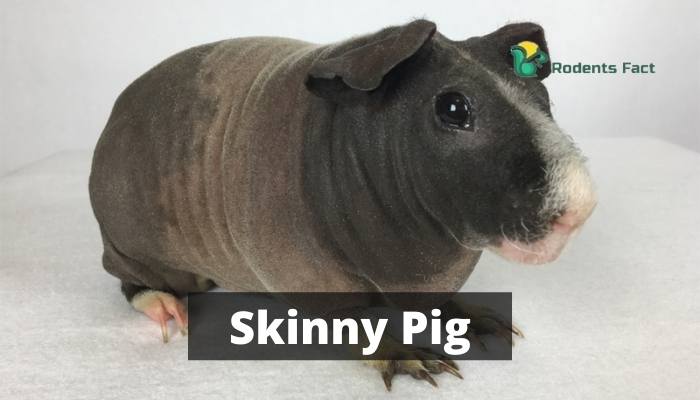Skinny Pig | Facts, History, and Everything You Might be Excited About
Many people know about the existence of hairless animals like the Sphynx cat or the Xolotl dog, but not many people are familiar with the Skinny Pig. If you’re looking for a unique pet, you might be interested in a skinny pig.

These hairless creatures are becoming increasingly popular as pets, but they’re still relatively new to the scene.
Skinny pigs are a hairless breed of guinea pigs that was first developed in the United Kingdom in 1978. Instead, this hairless look is achieved through a process of selective breeding. Skinny pigs are bred without fur through generations of breeding hairless guinea pigs with each other.
While they may look different from their furry cousins, skinny pigs are just as friendly and social.
Facts about Skinny Pig
| Species Name | Skinny Pig |
| Family | Caviidae |
| Species Name | Cavia porcellus |
| Temperature | 65-75°F |
| Size | 9-12 inches long, 1-2 pounds |
| Temperament | Friendly, outgoing, social |
| Lifespan | 5-7 years |
| Color | Dutch, brindle, Himalayan |
| Minimum Tank Size | 7.5 square feet per pig |
The History Behind The Skinny Pig
A crossbreeding effort between regular-haired Guinea pigs and a hairless lab strain produced the skinny pig breed. The genetically altered strain of hairless Guinea pigs was initially identified in a Montreal laboratory in the 1970s.
The Skinny Pig was developed to be a hairless guinea pig with less body fat and longer legs, which made it ideal for use in research laboratories. Skinny Pigs are still used in research, but they have also become popular pets.

In the 1990s, the Skinny Pig was introduced to the pet industry. With both pet owners and Cavy lovers, they have grown in favor over time.
Skinny Pig Temperament
Most other guinea pig breeds share skinny pigs’ disposition. When appropriately trained, they are considered gentle and make excellent companions. Additionally, skinny pigs are very gregarious creatures.

It could take some time to get used to touching a furless animal, but skinny pigs make for lovely companions if they’re used to being handled.
If your skinny pig learns that you provide a dependable heat source when feeling chilly, they could be even friendlier to you in the winter. Most of them prefer a suitable partner of the same species, yet they can get desensitized to other animals and people.
Guinea pigs are naturally social and exhibit a wide range of behavioral characteristics. There may be specific indicators that the skinny pig dislikes you.
Skinny Pigs Appearance
Skinny pigs are a popular pet choice for many reasons, including their unique appearance. As the name suggests, these pigs are much thinner than the average guinea pig and have a very different appearance.
While they may look like hairless rats, they are a type of guinea pig bred to have minimal fur. This makes them ideal for people with allergies and those who simply prefer a low-maintenance pet. Skinny pigs come in various colors and patterns and are typically amiable and social creatures.

Read More: Teddy Guinea Pig: Fact, Personality, Health Issues, and Caring
Cage Size
When it comes to skinny pigs, cage size is essential. A general rule of thumb is that the cage should be at least two times the length of the pig and 1.5 times the width.
This will ensure that your pig has enough room to move around and stay active. Of course, every pig is different; some may need more or less space than others.
If unsure, it’s always best to avoid caution and get a larger cage. After all, you can always put toys and other enrichment items in the cage to help keep your pig entertained and occupied.
In some regions of North America, beavers are noted for building large dams. The quantity is dwindling. Read our guide, “What Would Happen if Beavers Went Extinct?”
Health of Skinny Guinea Pig

Guinea pigs without hair typically have fewer health issues than their hairy counterparts. Due to their history and breeding issues, hairy Guinea pigs can have poorer immune systems than other species. But a well-raised skinny pig should be just as resilient as a hairy Guinea pig.
If you’re considering taking your hairless guinea pig outside, use a high-factor sunscreen to prevent burning and skin cancer.
The lack of natural insulation in the form of hair means that hairless Guinea pigs must be kept warm. This implies that you cannot leave them outside and must keep them inside in a cozy, warm setting.
Why Is Vitamin C Necessary for Skinny Guinea Pig?
As guinea pigs cannot produce ascorbic acid or vitamin C naturally, it is critical to add vitamin C to their diets to preserve their health and hasten healing in the event of an injury.
Vitamin C is crucial for immune system stimulation and scurvy prevention, and adding it to your guinea pig’s diet is one of the best things you can do to ensure a long and healthy life for your furry friend.
The following video shows the skinny pig eating pallets:
Caring For A Skinny Pig
A skinny pig is a hairless guinea pig bred to have very little body fat. They are commonly used in research laboratories and as show animals. Skinny pigs are susceptible to temperature changes and can quickly dehydrate or overheat.
It is crucial to provide them with a comfortable and stable environment. Skinny pigs require special care to stay healthy and comfortable. They should be kept in a temperature-controlled environment and provided plenty of fresh water.

Their diet should consist of high-quality hay, fresh vegetables, and a small number of pellets. Skinny pigs should be groomed regularly to prevent skin irritations. Proper care for your skinny pig will ensure your pet’s long and happy life.
Is a Skinny Pig Right Companion For You?

The “Skinny Pig” is a hairless breed of guinea pig that has become popular in recent years. While they may look different than a traditional guinea pig, they are the same species and have the same personality traits. This makes them ideal for people with allergies or who simply prefer a hairless pet.
While they may look different from traditional guinea pigs, they are just as friendly and make great pets. So, if you are considering getting a guinea pig, a Skinny Pig may be the right choice for you!
Frequently Asked Question
What should I do if my skinny pig’s skin is dry?
The skin types of different Hairless Guinea Pigs vary. Oily, standard, and dry skin types can all be found in skinny pigs. The upkeep of a healthy look is simple. Products like Cold Pressed Coconut Oil might benefit Skinny Pigs with somewhat dry skin.
Are skinny pigs cruel?
They make lovely pets since they are playful, curious, kind, and friendly. Skinny pigs are born with only a few hair tufts on their noses and feet and are otherwise entirely bare, exposing their chubby bodies and stumpy legs.

Final Words
The skinny pig is a hairless breed of guinea pig that was developed in the 1970s. Although they are hairless, they are not completely bald – they have a fine layer of downy fuzz that covers their bodies.
Skinny Pigs are typically calm and gentle and make great pets for children and adults alike. Skinny pigs require special care and should be kept in a warm, humid environment.




